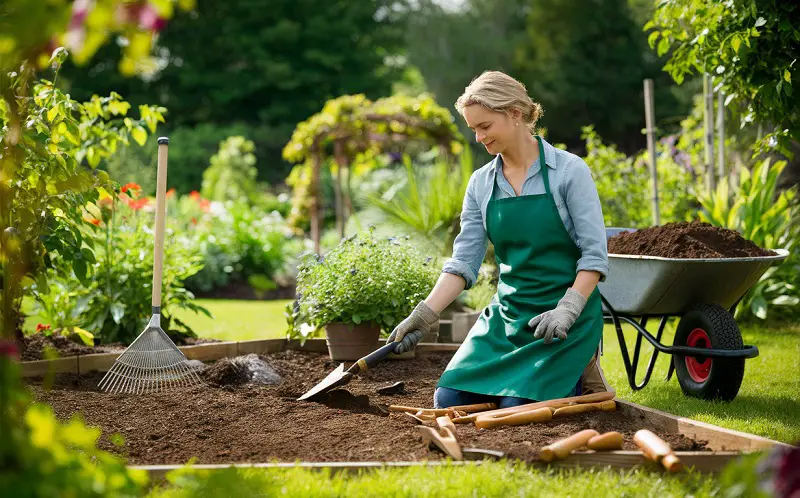Preparing your garden soil is the foundation of a successful garden. Whether you’re a seasoned gardener or a beginner, getting the soil ready is crucial for healthy plants and bountiful harvests. The quality of your soil determines how well your plants absorb nutrients, water, and oxygen.
This guide covers simple, effective steps to prepare your garden soil for planting and ensure that your plants thrive throughout the growing season.
1. Understanding Your Soil Type
Before diving into soil preparation, it’s essential to know what type of soil you have. The three main types are sand, silt, and clay. Each has its unique characteristics:
- Sandy Soil: Drains quickly but struggles to retain nutrients.
- Clay Soil: Rich in nutrients but tends to be heavy and drains poorly.
- Silty Soil: Retains moisture and nutrients but can compact easily.
A simple test is to take a handful of moist soil and squeeze it. If it crumbles easily, it’s sandy. If it holds its shape and feels sticky, it’s clay. If it holds together but falls apart with slight pressure, it’s silty. Understanding your soil type will help you determine what amendments are needed.
2. Testing Your Soil’s pH Levels
Soil pH impacts nutrient availability. Most garden plants prefer a pH range of 6.0 to 7.0. You can purchase a soil testing kit from a garden center or send a sample to a local extension service. If your soil is too acidic (below 6.0), you may need to add lime to raise the pH. If it’s too alkaline (above 7.0), sulfur or organic matter can lower it. Adjusting the pH ensures your plants can effectively absorb nutrients.
3. Clearing the Area of Weeds and Debris
Start by clearing your garden space of any weeds, rocks, or old plant debris. Weeds compete with your plants for nutrients and water, while debris can harbor pests and diseases. Use a garden hoe or hand tool to remove these unwanted elements, ensuring a clean slate for planting.
4. Tilling or Loosening the Soil
Once the area is clear, it’s time to till or loosen the soil. Tilling breaks up compacted soil, allowing roots to penetrate more easily and improving water drainage. However, avoid over-tilling, as this can damage soil structure and lead to erosion. For smaller gardens, you can use a garden fork or spade to loosen the top 6 to 8 inches of soil.
5. Adding Organic Matter
Healthy soil is rich in organic matter like compost, aged manure, or leaf mold. These materials improve soil structure, enhance nutrient content, and boost water retention. Spread a 2 to 4-inch layer of organic matter over the soil and mix it in. Organic matter also encourages beneficial microbes and earthworms, which play a crucial role in breaking down nutrients for plant uptake.
6. Balancing Soil Nutrients with Fertilizer
Even with organic matter, your soil might need a nutrient boost. A balanced fertilizer, often labeled as 10-10-10, provides equal parts of nitrogen, phosphorus, and potassium—key nutrients for plant growth. Depending on your plants’ needs, you may choose specialized fertilizers with more of one nutrient, such as high-nitrogen fertilizers for leafy vegetables. Always follow the instructions on the fertilizer package to avoid over-fertilizing, which can harm your plants.
7. Improving Soil Drainage
Poor drainage leads to waterlogged roots, which can suffocate plants and promote root rot. If your garden has heavy clay soil, consider amending it with coarse sand, perlite, or fine gravel. Raised beds are another excellent solution for areas prone to poor drainage. They allow excess water to flow away more easily, creating a healthier environment for root growth.
8. Mulching to Protect Your Soil
Applying mulch is a vital step after planting. Mulch helps retain moisture, suppress weeds, and regulate soil temperature. Organic mulches like straw, wood chips, or shredded leaves also break down over time, adding more nutrients to the soil. Spread a 2 to 3-inch layer around your plants, being careful not to pile it against stems, which can lead to rot.
9. Monitoring and Adjusting Soil Over Time
Garden soil isn’t a one-time fix. As the growing season progresses, regularly check the soil’s moisture level, pH, and nutrient content. Adding additional compost mid-season can help replenish nutrients, while spot-treating with specific fertilizers may address any deficiencies that arise. Continuously monitoring and adjusting your soil will keep your plants healthy and productive.
10. Planning for Crop Rotation
If you grow vegetables, practicing crop rotation is essential for maintaining soil health. Rotating crops helps prevent soil-borne diseases and reduces the depletion of specific nutrients. For example, after growing heavy feeders like tomatoes, follow up with legumes that fix nitrogen in the soil. Plan your garden layout with crop rotation in mind to keep your soil fertile year after year.
Conclusion
Preparing your garden soil for planting is a straightforward yet vital process that sets the stage for a bountiful harvest. By understanding your soil type, adjusting its pH, incorporating organic matter, and staying vigilant throughout the growing season, you give your plants the best chance to thrive.
Whether you’re growing flowers, vegetables, or herbs, taking the time to care for your soil will result in healthier, more vibrant plants and a more successful garden overall. Follow these simple steps, and you’ll be well on your way to cultivating a garden that flourishes all season long.
